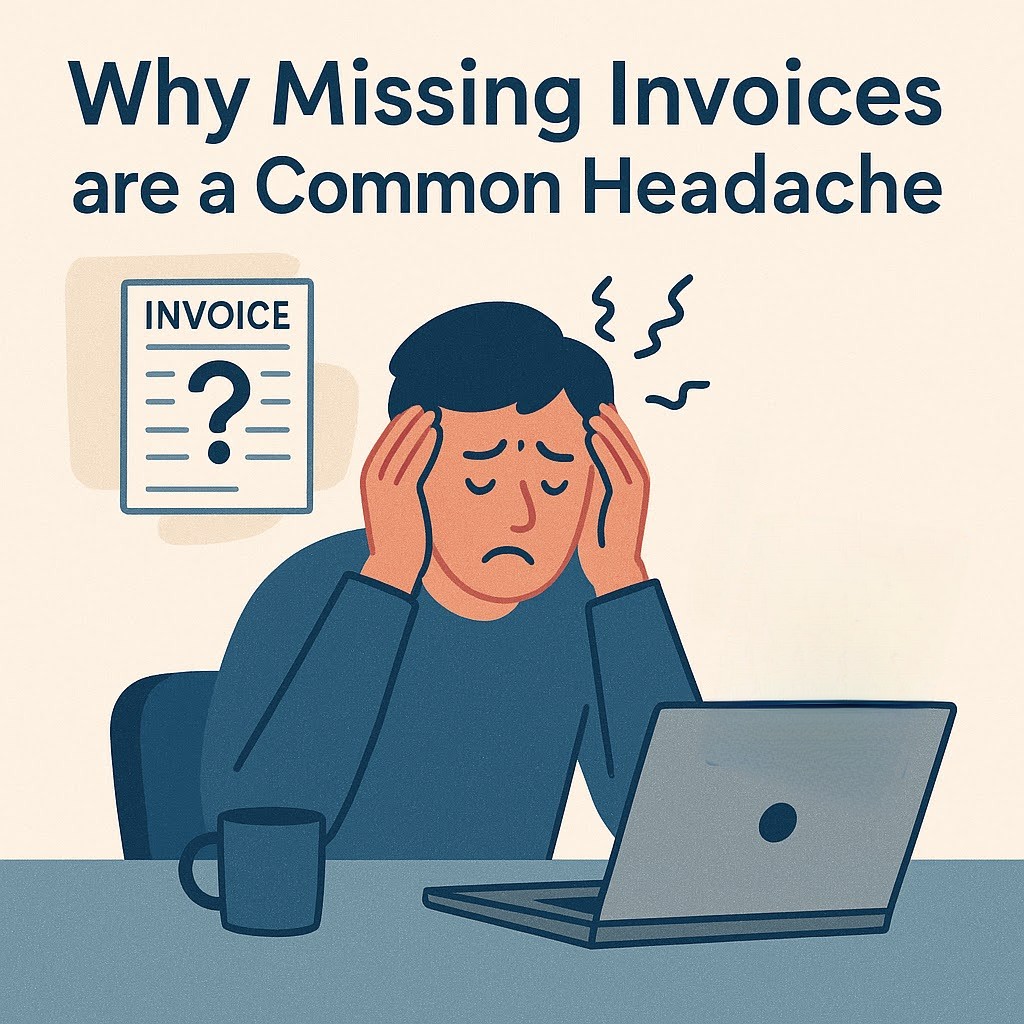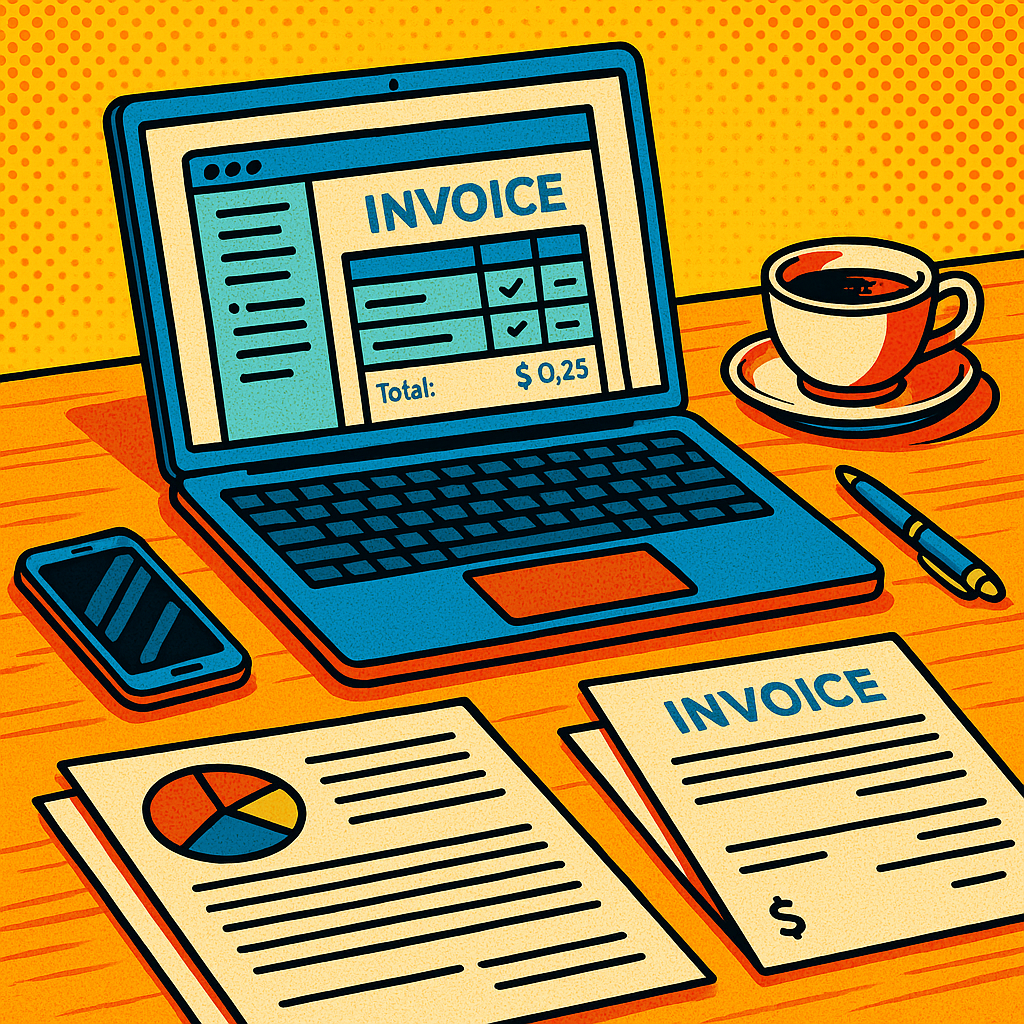Quick reality check: we’ve all spent thousands on SaaS tools that promised “paper-less perfection,” yet a vendor still calls on the 28th asking, “Did you ever get that invoice?” How does that happen? Simple—cloud storage solves for availability, not process. A project manager drags the PDF into Drive, accounting waits for a formal hand-off, and somewhere in that gap the file dies of neglect. I’ve seen an agency miss its own quarterly bonus because a €2,400 Facebook-ads invoice vanished between a Slack thread and a shared folder. No malice, just entropy. And yes, it was “Searchable.” Good luck remembering whether the vendor called it “FB_Ads_Mar” or “Invoice-0324.”

The Hidden Cost of Missing Documentation on Cash Flow & Tax Compliance
What’s the price tag? For starters, delayed cost recognition distorts your margin and your cash-burn runway. Two false positives and your CFO is forecasting sunshine while a storm is forming off the books. Then come the tax auditors. In Germany, for example, failure to produce a supplier invoice within ten days can trigger a 10% input-VAT claw-back—ask our Berlin client who wired €18k to the Finanzamt after a routine audit. They’re now disciples of this 14-step playbook to stop cash leaks, but only after the painful lesson.
Meet InvoiceGenie: Re-Create Provider Invoices in Seconds
Here’s the part that makes controllers exhale: instead of begging the supplier for a re-send (and slipping down their priority queue), you pop the purchase order, payment confirmation, and delivery note into InvoiceGenie. The tool auto-fills SKU, tax codes, even the supplier’s legal address—basically everything you need for audit-proof recovery—and spits out a compliant PDF before the coffee is cold. No exaggeration; I timed it at 58 seconds during last month’s sprint demo. If you’re wondering how that squares with your existing workflow, the app exports directly to Xero and Netsuite, or you can grab a CSV and move on. Bonus: if you’re still evaluating, the free tier mirrors the generators outlined in our primer on free invoice generators, so there’s zero friction to test it.
Step 1 – Gather Every Data Crumb You Can Find
When a vendor PDF goes missing, my first instinct is to open the “breadcrumbs drawer.” I’m talking purchase orders in Jira, ACH confirmations in the bank feed, even WhatsApp screenshots. In a Q1 roundtable with a fintech client, we traced a €9 k tooling invoice by cross-referencing a Stripe payout ID with the supplier’s GitHub issues log—obscure, yes, but it surfaced the SKU list we needed. Moral: data rarely disappears; it just hides where search filters don’t reach.
Step 2 – Pick Your Reconstruction Method
Trend watch: controllers are ditching spreadsheets in favor of lightweight generators that “template-lock” tax fields. Why? Because spreadsheets let junior staff overwrite VAT rates at 2 a.m. (ask me how I know). Last month’s CFO Connect meetup showed a 43 % drop in reconciliation errors after switching to structured generators. If you’re still tempted by Excel, remember that the Garbage In, Garbage Out principle applies doubly when tax authorities are involved.
Step 3 – Generate the Invoice with InvoiceGenie (60-Second Demo)
Here’s the workflow we rolled out for a SaaS marketplace in April: drag the PO PDF into InvoiceGenie, hit “auto-import,” and watch line items, unit prices, and supplier details populate instantly. The app even flags missing company registration numbers—a lifesaver for our UK clients under MTD. During UAT we clocked an average time-to-invoice of 58 seconds; legacy ERP templates took seven minutes.
Step 4 – Validate, Record, and Send for Payment
Reconstruction isn’t finished until it’s audit-proof. We use a two-person checklist: I review tax codes; a junior confirms quantities against delivery notes. Once green-lit, the PDF auto-archives to our GL folder, and a journal entry posts to “Accrued Expenses.” Bonus tip: schedule a weekly Zapier task to surface any invoices older than 30 days without matching payment IDs. That single automation reduced our “invoice limbo” count from 27 to 4 in one quarter.
Data Gaps: What If Key Details Are Missing?
Now, you might be thinking, “Great theory, but what if the PO and bank memo don’t tell me the unit price?” Fair point. In practice you’ll run into three flavors of data void: price, tax code, and delivery date. My rule of thumb is to triangulate. No price? Compare neighboring invoices from the same vendor—rates rarely jump 40 % overnight. No tax code? Pull the supplier’s last compliant invoice and mirror the VAT treatment. Still stumped? Flag the line item in red, ship the draft to the vendor for confirmation, and freeze payment until they respond. Yes, it slows the cycle, but a slow month beats a penalty notice.
Supplier Pushback & Legal Considerations
But here’s the thing—some vendors freak out when you send them a document they “never issued.” They worry about duplicate revenue recognition or, worse, fraud accusations. The fix is transparency: attach the evidence trail (PO, bank proof, shipment receipt) and spell out that you’re recreating the invoice strictly for your books. In one recent onboarding, a hardware wholesaler demanded we watermark every recreated PDF with “Generated by Buyer” before they’d sign off. Annoying? Sure. Yet it avoided a week of back-and-forth and preserved the relationship. Remember, compliance is a two-player game; let the supplier save face.
Tax Authority Red Flags to Watch Out For
Finally, let’s talk auditors. They love patterns, and recreated invoices can look like forged stamps if you aren’t consistent. Mix-and-match templates? Wrong sequential numbers? That’s audit bingo. Standardize your naming convention—our go-to is “INV-REGEN-YYYYMM-###”—and embed metadata noting the creation date and source docs. One client in Madrid sailed through a random IVA audit because every regenerated invoice carried a footer referencing the original PO number; the inspector literally said, “Gracias por la trazabilidad.” Translation: traceability keeps fines at bay. Cut corners here and, well, enjoy explaining your life choices to the tax office.
Remember that marketing agency whose invoice evaporated in Drive? We opened with that anecdote not for drama but because it’s the rule, not the exception. Digital stacks may be bullet-proof on paper, yet human gaps—Slack threads, forgotten email attachments, ambiguous file names—keep sabotaging us. The good news? Lost invoices no longer have to end in frantic supplier calls or audit-nightmares. If you do nothing else, bank these five ideas:
Information hides, it rarely vanishes. Think breadcrumbs: bank memos, PO logs, chat exports. Pull on all those threads before declaring defeat.
Structure beats speed. A 58-second generator is great, but only if it locks VAT rates, numeric sequences, and metadata every single time.
Transparency keeps lawyers away. Watermark recreated PDFs, share your evidence trail, and you won’t set off vendor panic alarms.
Audit-proofing is a naming convention, not a magical seal. One consistent prefix—“INV-REGEN”—was all it took for our Madrid client’s inspector to say, “Gracias.”
Automation is a habit, not a feature. Weekly Zapier sweeps, quarterly invoice audits, whatever rhythm works—just make the metronome tick.
Frequently Asked Questions
1. Why does the article “How to Create Lost Invoices: The 2024 Playbook for Entrepreneurs” insist on “Gather Every Data Crumb You Can Find” before anything else?
Because invoices are merely structured summaries of transactions, reconstructing them starts with evidence. Bank memos, Slack threads, PO numbers—each “crumb” fills a different information gap. Skipping this step risks hard-coding errors (wrong VAT rate, quantity, or even supplier name) that snowball into compliance penalties.
2. How is the “Four-Step Formula to Re-Create a Lost Invoice (Without Losing Your Sanity)” better than the old spreadsheet-and-pray approach?
The four steps—collect, choose a generator, auto-populate, and validate—replace ad-hoc typing with a repeatable workflow. By forcing you to select a structured generator early, it locks tax fields and naming conventions, eliminating the two most common audit flags: inconsistent numbering and missing VAT identifiers.
3. In the section “Data Gaps: What If Key Details Are Missing?”, triangulation was mentioned. What’s the safest triangulation tactic when price data is absent?
Start with adjacent invoices from the same vendor and month—prices rarely swing wildly period-to-period. If that fails, reference the purchase order or contract. Still nothing? Issue a draft marked “Price Pending” and ask the supplier to confirm. This keeps your books transparent and your audit trail intact.
4. Is there a recommended time window to finish a recreation so the tax office doesn’t raise an eyebrow?
Best practice is within the same reporting period—monthly for VAT filings in most EU countries, quarterly in the U.S. Waiting longer increases the risk of mismatched accruals and draws regulator scrutiny, especially if material amounts appear “out of the blue.”
5. Where can I dig deeper if I need a more granular day-by-day plan?
Check out the detailed roadmap in this 7-day fix and expert playbook. It complements the concepts from our article by giving you daily checkpoints, templates, and reminder scripts to nudge lagging suppliers.

